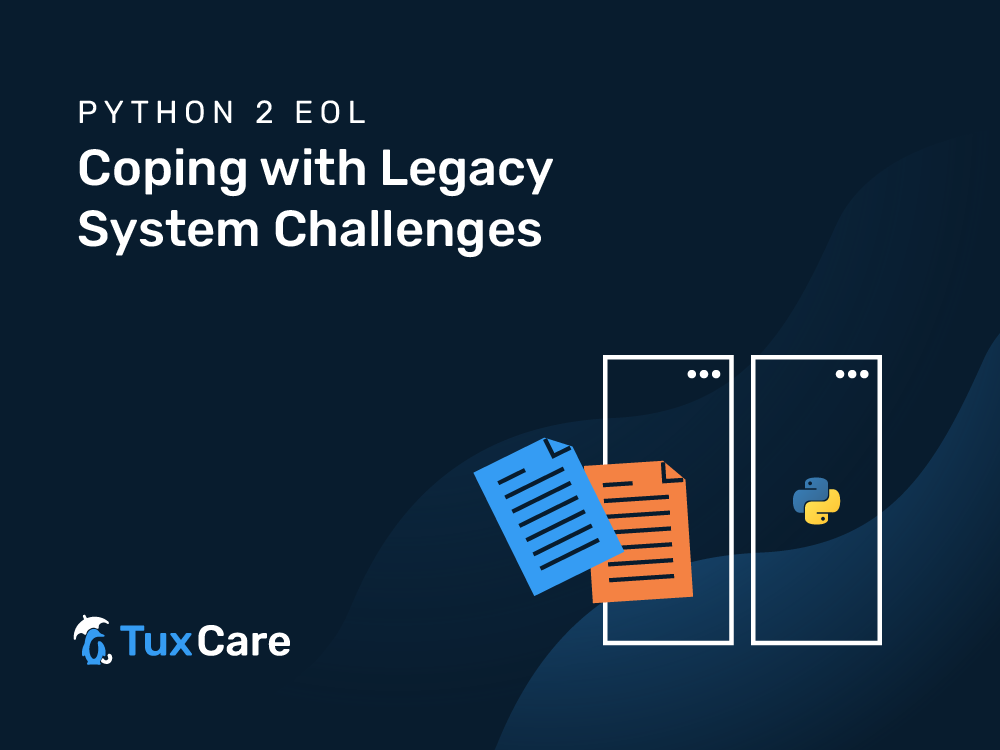Python 2 EOL: Coping with Legacy System Challenges
- Python 2 was officially maintained and supported until January 1, 2020.
- The system becomes highly vulnerable without Python 2 security updates.
- TuxCare’s ELS for Python provides security fixes for Python 2.7 versions.
Python 2.7 was the last major version in the 2.x series of this software language, which was launched on July 3, 2010 and was officially maintained and supported until January 1, 2020. At that point, when the Python 2 EOL (End of Life) phase began, the legacy systems still running on it began to face several challenges. The systems can be exposed to potential vulnerabilities and risks because there are no longer official updates being delivered, including security patches.
In this blog post, we will discuss the challenges dealing with legacy systems still running on Python 2 after its EOL and offer advice on mitigating the risks.
What Is a Legacy System?
Legacy systems are outdated systems, software, or technology that are still in use despite newer options being available. Legacy systems sometimes no longer meet compliance requirements. These systems are often characterized by older technologies, programming languages, or hardware that have been surpassed by more modern and efficient alternatives.
One of the major reasons that organizations shouldn’t continue using legacy systems is that vendors discontinue providing updates, patches, and technical support for the hardware or software components. For example, Python 2 EOL, CentOS 8, Ubuntu 18.04 EOL all fall under this category. However, many organizations continue to use these legacy systems because they are required for critical operations, and replacing or migrating them can be expensive, challenging, and time consuming.
Challenges of Python 2 End of Life
Organizations that continue using end-of-life Python versions will likely face the following issues:
Security Risks
Python 2 will not receive further updates, patches, or technical support from the Python Software Foundation. Therefore, the biggest issue is that systems are left open to new and emerging threats due to the lack of security updates.
Compatibility Issues
Many libraries and frameworks no longer support Python 2, limiting the compatibility of existing codebases. Additionally, integrating newer systems or services might become problematic due to Python 2 incompatibility.
Lack of Community Support
As the Python community has shifted its focus to Python 3, finding support and resources for Python 2 becomes increasingly difficult.
Risk Mitigation for Python 2 End of Life
Code Assessment: Examine your codebase thoroughly to determine which modules, libraries, and dependencies still rely on Python 2 EOL.
Migration Plan: Develop a comprehensive migration plan detailing the procedures, resources, and schedule for transitioning to Python 3. You may also consider seeking help from Python development experts or consultants who specialize in migrations.
Speak to a TuxCare expert who can guide you in your application transformation journey to Python 3.x for AlmaLinux, Rocky Linux, or RHEL 9 systems.
Testing Migration: At each migration phase, make significant investments in testing. Unit tests and integration tests are essential to identify regressions and ensure applications continue to function as intended after the migration.
Ensuring Compatibility: Verify that Python 3 is compatible with all third-party modules and dependencies. If not, look for alternatives or help the community update them.
Utilize Community Resources: Make use of internet forums, communities, and documentation to seek guidance and solutions from others who have undergone similar migrations.
Python 2 Extended Support: If the migration is complex and time consuming, consider using TuxCare’s Extended Lifecycle Support for Python 2.7 to mitigate the security risks associated with the lack of Python 2 official support. TuxCare takes care of all security vulnerabilities, while you can continue to use existing Python 2.7 applications on AlmaLinux, Rocky Linux, or Red Hat Enterprise Linux 9. This ensures the system remains safe and compliant with regulatory requirements.
Final Thoughts
Dealing with legacy systems still running on Python 2 EOL presents several challenges and requires a strategic and well-planned approach. A successful transition to Python 3 can be ensured by implementing a systematic migration plan, doing comprehensive testing, and collaborating with the community.
Get started with TuxCare’s Extended Lifecycle Support for Python to utilize Python 2.7 software on AlmaLinux, Rocky Linux, or RHEL 9 while staying secure from critical vulnerabilities.
For additional information, read our previous blog Business Value of ELS Patching for Python.



 Documentation
Documentation Login
Login




